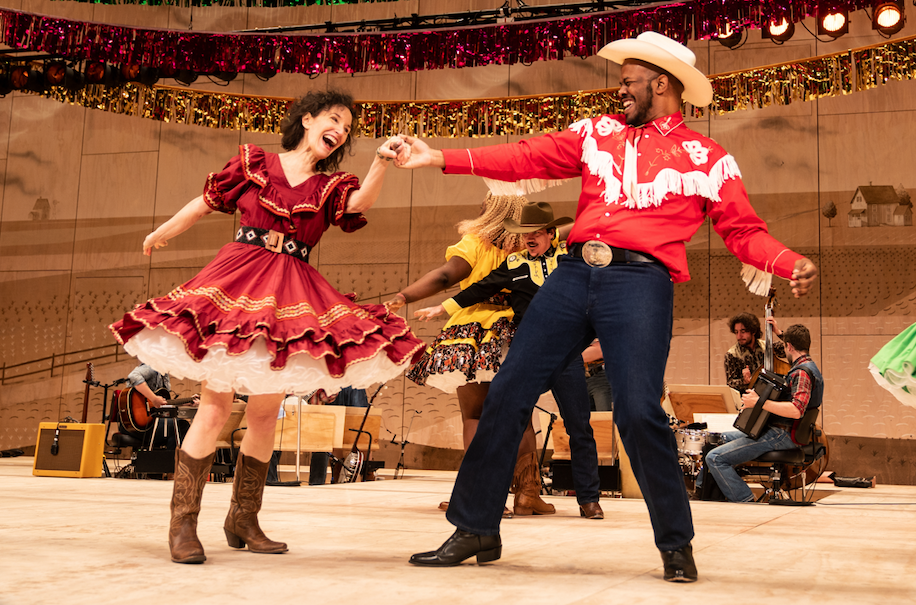
Prior to attending the Music City Opening Night performance of the current National Tour of Rodgers and Hammerstein’s Oklahoma!, which continues at TPAC’s Jackson Hall through Sunday, May 8, I had heard a wide range of opinions about Daniel Fish’s Tony-winning revival. Heck, I’d even formed a few preconceived notions myself, considering the original 1943 production, and Hollywood’s iconic film adaptation that followed a decade later are the stuff of which legends are made.
Among the rumblings, folks seem to be out of joint for a variety of reasons. Some feel it’s too dark and brooding. Others don’t care for the ‘checking every box’ overly-politically correct nature of the casting, or the striped down consolidation of the action now all taking place at a barn dance, rather than the typical multiple set-changes. Still others apparently have their petticoats in a twist because of the amped-up sexual tension, potentially triggering subject matter and interesting choices concerning everything from the choreography to the over-exaggerated accents.
I’m here to tell you, within the first few minutes, for me at least, very little of that mattered. Even as the audience made their way to their seats, Jackson Hall was lit a little brighter than usual, thanks to the curtain being up on the stage and Scott Zielinski’s overly-saturated bright white lighting making the sparse set almost glow. As for the set, Laura Jellinek’s simply but purposeful stark set which seems to depict the interior of a barn or social gathering spot with a few rows of picnic tables and a wall lined with rows and rows of gun racks full of rifles. The play is set in Indian Territory in 1906, after all. This might not be the farmhouse, surrey, corale or paddocks to which audience have grown accustomed, nonetheless, it still seems familiar and easy.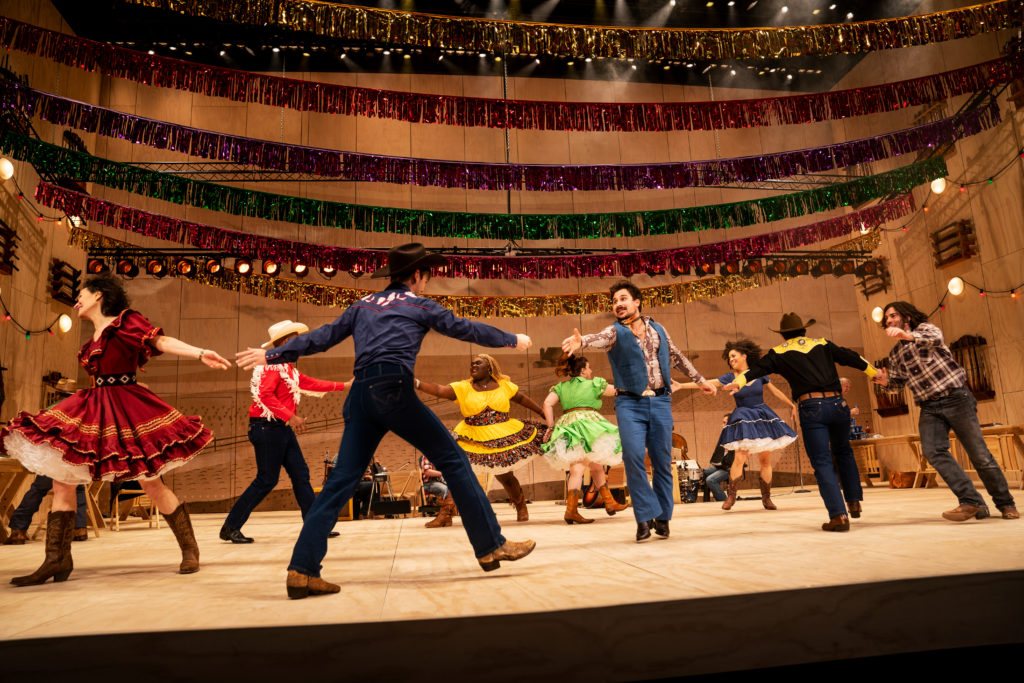
In preparation for my recent Rapid Fire 20Q during which I chatted with members of the cast of Oklahoma!, I fell down a YouTube rabbit hole and discovered an old black and white clip of an early stage mounting of the show, so as soon as I saw the scrim that covers the back of the stage with it’s simple graphic of a farmhouse and a barn set along the great expanse of the land, I realized it’s a brilliant nod to Lemuel Ayers’ original Broadway set design for that early scrim is almost identical. From the familiar opening number, Oh What a Beautiful Morning, now presented in a less-than-optimistic slower tempo, it’s indeed evident this is not only a revival, but a complete reimagining. Sean Grandillo’s Curly, completely opposite the usual strapping buck of a leading man, is a slight young young thing…with straight hair at that. But here’s what he has going for him in spite of his less-than-intimidating presence, this Curly’s got swagger, confidence, a strong tenor voice and can play a mean lick on his guitar.
On the subject of the show’s soundtrack, gone are the sweeping full orchestrations of previous incarnations, replaced instead by a 7-piece on-stage orchestra. Alright, calling it an orchestra seems a little grandiose. In keeping with this new Oklahoma!, it’s more like a house-band made up of Andy Collopy who serves as conductor, as well as playing the accordion and drums; associate conductor, Dominnic Lamorte, who also plays upright bass; Rick Snell on mandolin & electric guitar; Liz Faure on pedal steel, acoustic and electric guitar; Justin Hiltner on Banjo, Libby Weitnauer on Violin (come on, that’s a fiddle) and Grace Hartman Parce on Cello. I mention the band early on simply because Daniel Kluger’s new orchestrations and arrangements are a vital part of why this production skews darker than we’re used to.
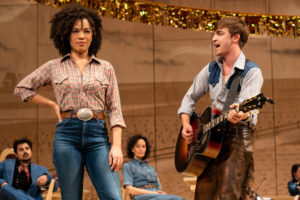 Another genius aspect of this incarnation is that while the tempo of the tunes and the emotion and intonation of the delivery may have changed, the lyrics, and for that matter, the dialogue is the exact same as it has always been. A prime example of how this affects the mood and meaning of the show is seen when Curly attempts to woo Laurey (Sasha Hutchings) as he describes the fancy horse-drawn surrey he intends to take her to the comping social in. With no change at all in the lyrics, but a slower, more seductive delivery, he describes taking her on a date, keeping her out all night and waking up still in the surrey together. The tune’s lyrics “whoa! You team, and just keep a-creepin’ at a slow clip clop. Don’t you worry with the surrey with the fringe on the top” suddenly take on a new meaning. Is Curley telling Laurey not to worry if anyone see’s their surrey ride of shame the next morning as the top of the carriage will keep their secret? Maybe. Maybe not.
Another genius aspect of this incarnation is that while the tempo of the tunes and the emotion and intonation of the delivery may have changed, the lyrics, and for that matter, the dialogue is the exact same as it has always been. A prime example of how this affects the mood and meaning of the show is seen when Curly attempts to woo Laurey (Sasha Hutchings) as he describes the fancy horse-drawn surrey he intends to take her to the comping social in. With no change at all in the lyrics, but a slower, more seductive delivery, he describes taking her on a date, keeping her out all night and waking up still in the surrey together. The tune’s lyrics “whoa! You team, and just keep a-creepin’ at a slow clip clop. Don’t you worry with the surrey with the fringe on the top” suddenly take on a new meaning. Is Curley telling Laurey not to worry if anyone see’s their surrey ride of shame the next morning as the top of the carriage will keep their secret? Maybe. Maybe not.
As for Laurey, Hutchings strikes a gorgeous, tall figure of a woman and her voice possesses a raw throaty quality. It’s almost as if she’s singing from the back of her mouth and not at full power, but it kinda works. It adds to Laurey’s predicament of being the object of affection to more than one man. I do have to say this, though. Both my companion for the evening and I noticed Hutchings kept futzing with her hair, constantly doing an almost exaggerated sweeping motion with her hand, pushing it up and presumably away from her face. It became an odd distraction for me and my friend.
Hennessey Winkler is cast in the role of Will Parker, who takes on the next song in the show, Kansas City, a tune that extols the fabulousness of the nearby modern town. In the playfully capable hands of Winkler, who was quoted in a recent interview admitting Ado Annie was a dream role, until he transitioned to male, you gotta wonder though, have they indeed “gone about as far as they can go”? While singing about a particularly voluptuous female he encountered at a burlesque show, he recalls, “One of the gals was fat and pink and pretty. As round above as she was round below”. Y’all! Those lyrics! And again, thanks to his delivery, that description takes on a whole other super-sexualized meaning. Made all the more obvious by Winkler picking up a shucked ear of corn on the nearby picnic table and holding it just so, as to suggest…how shall I say this…the early 1900s equivalent of today’s eggplant emoji. Hilariously, a similar suggestive ideal comes later when the ladies all shuck corn, then violently begin to break the cobs in half as they toss them into a barre during Many a New Day. I can’t be the only person who saw these not so subtle things and thought these bawdy campy thoughts, right?
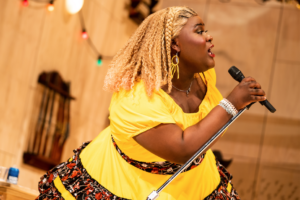 Speaking of camp, enter Ado Annie played by trans actress and activist, Sis. Here’s the deal, I myself am a member of a couple of less-than-equally-represented demographics, one being I was born with a neuromuscular disorder that now requires I use forearm crutches to walk, so when Fish debuted his Oklahoma! on Broadway coinciding with the show’s 75th anniversary and he cast wheelchair-using actress/singer Ali Stoker as Ado Annie, who subsequently won the Tony, I was all for it. Now, when the tour was announced and Stoker’s star was on the rise, I figured she wouldn’t join the tour, but I had kinda thought they might cast another wheelchair’d actress. Nope. Sis won the role. Again preconceived notions and my own thoughts of the powers that be overcompensating for decades of Broadway literally and figuratively being the great white way, by checking all the boxes was my initial reaction. But the minute Sis breaks into Ado Annie’s signature song, I Cain’t Say No, I was done…in the best way possible. Sis, who is the very definition of a big, Black, beautiful woman, owns that song, the stage and everything that comes with it. As if the first few verses aren’t enough, she goes to the rear of the stage, grabs the mic from the stand by the band, comes back to the edge of the stage and breaks out into a rollicking reprise. Plus, the juxtaposition of Winkler’s Will Parker and Sis’ Ado Annie, is a perfect comedic role reversal in every sense of the word. Yes, it’s ok to laugh, ‘cause guess what, they’re totally in on it.
Speaking of camp, enter Ado Annie played by trans actress and activist, Sis. Here’s the deal, I myself am a member of a couple of less-than-equally-represented demographics, one being I was born with a neuromuscular disorder that now requires I use forearm crutches to walk, so when Fish debuted his Oklahoma! on Broadway coinciding with the show’s 75th anniversary and he cast wheelchair-using actress/singer Ali Stoker as Ado Annie, who subsequently won the Tony, I was all for it. Now, when the tour was announced and Stoker’s star was on the rise, I figured she wouldn’t join the tour, but I had kinda thought they might cast another wheelchair’d actress. Nope. Sis won the role. Again preconceived notions and my own thoughts of the powers that be overcompensating for decades of Broadway literally and figuratively being the great white way, by checking all the boxes was my initial reaction. But the minute Sis breaks into Ado Annie’s signature song, I Cain’t Say No, I was done…in the best way possible. Sis, who is the very definition of a big, Black, beautiful woman, owns that song, the stage and everything that comes with it. As if the first few verses aren’t enough, she goes to the rear of the stage, grabs the mic from the stand by the band, comes back to the edge of the stage and breaks out into a rollicking reprise. Plus, the juxtaposition of Winkler’s Will Parker and Sis’ Ado Annie, is a perfect comedic role reversal in every sense of the word. Yes, it’s ok to laugh, ‘cause guess what, they’re totally in on it.
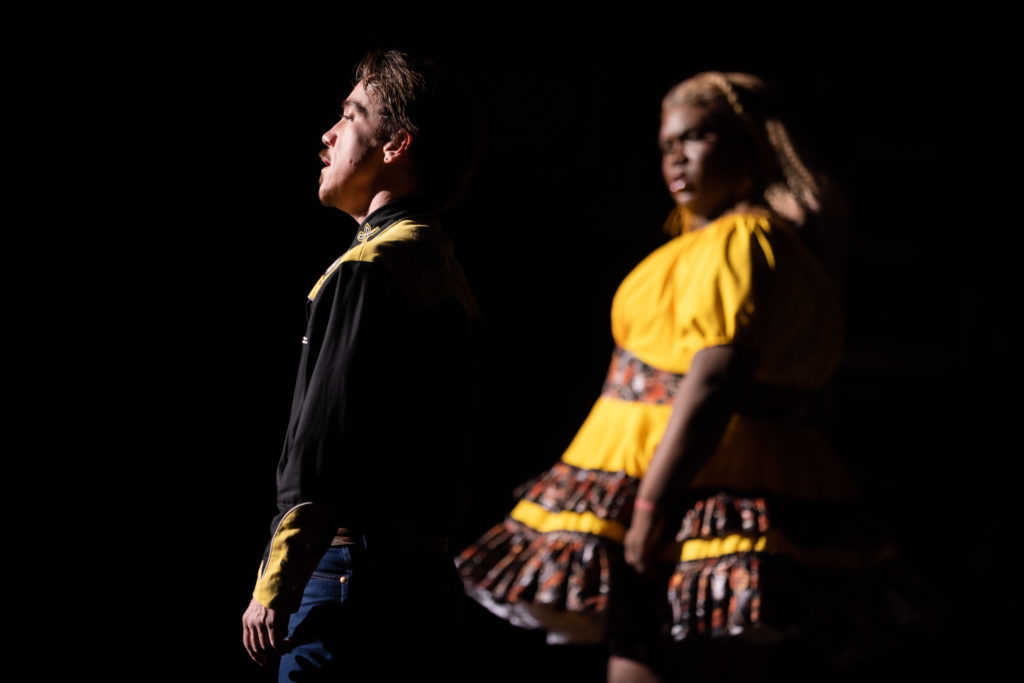
Other standout performances come by way of Benj Mirman as Ali Hakim and Barbara Walsh as Aunt Eller. Mirman’s Hakim, the Persian peddler who finds himself unexpected betrothed to Ado Annie at her father’s (Mitch Tebo) insistence, gets his shining moment with It’s a Scandal, It’s a Outrage. As for Walsh’s Aunt Eller, she gets a section of choice comebacks and knowing glances throughout the show, as well as featuring prominently during most of the all-in moments.
Then there’s Christopher Bannow’s Jud Fry, in spite of the fact that Jud doesn’t really say much during the first half of the show, thanks to director Fish’s keen sense of anticipation, even when Jud is just sitting there at one of the picnic tables while Curly flirts with Laurey, he can be seen, reacting. Doing things as seemingly inconsequential as shifting in his seat, or sitting up a little straighter when Laurey walks near him or listening more intently when she’s talking. All of this leads up to one of the show’s most volatile and creative scenes.
Curly, realizing Jud also has his eye on Laurey, pays Jud a visit. While there, he goes so far as to suggest that Jud hang hmself, explaining by the lyrically sinister Pore Jud is Daid that if he offs himself, he will finally garner the love and empathy of Laurey and the entire town. Adding to the drama of this scene, the entire theatre goes completely black and the two men talk to each other using handheld mics. Suddenly out of the darkness, Jud’s face is projected in black and white on the scrim behind the stage, thanks to a member of the crew and a handheld video cam. It’s at this precise moment that the rows of seats between the audience and the actors effectively disappear, making the audience truly feel part of the show. Interesting, considering the fact that during the show’s Broadway run, it was housed in the very intimate Circle In The Square Theatre, a 776 seat theatre in the round, where the audience surround the stage on all four sides. Furthermore, during the first act of the Broadway run, the cast literally made chili and cornbread which they served to the audience during intermission.
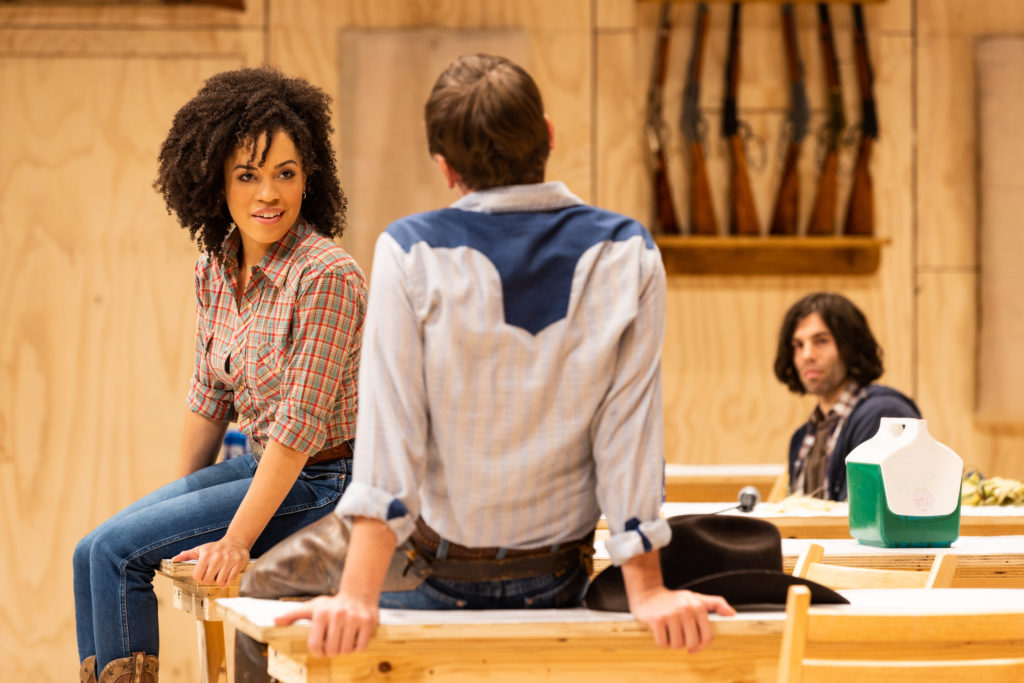
Of course that intimacy isn’t possible for a National Tour, but the dimming of the lights and then the projection of the actors faces in severe close up, for that moment, bridges the distance and effectively achieves that closeness. Jud’s Lonely Room follows and his isolation and emotion during this song, simply heart wrenching.
The blackout effect is successfully used a second time when Laurey and Curly get a little intimate on a date, unfortunately, the smacking of their lips into their handheld mics during this scene turn a heated romantic moment into an uncomfortable exaggeration.
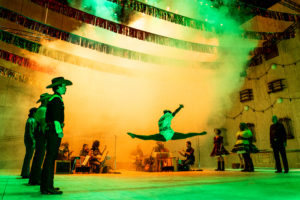 Another major difference between traditional mountings of the show and the current version is the fact that the Dream Ballet, originally choreographed by Agnes de Mille, and the stuff of which legends are made, has shifted from the end of Act 1 just after Laurey solo’s on Out of My Dreams, to the top of Act 2. Not only that, gone are the stunningly ethereal movements of most of the cast members and they bring to life Laurey’s dream/nightmare of being torn between two men. Instead, a single barefoot dancer emerges wearing an iridescent white t-shirt emblazoned with the message “Dream Baby Dream”. This might be my one biggest disappointment with the update. I get that it’s modern dance, but scooting across the stage like a puppy with a clogged gland, that’s not dance, that’s just bizarre. Now, I’m no dancer, though I did win the dance contest at homecoming in high school one year, but let’s face it, it was a popularity vote, but I digress. Again, my companion for the evening had a little to say about this particular moment. She is a trained dancer, so there’s some merit in her reaction. She too felt as if we were watching the equivalent of a young child performing for the family in the living room after Sunday dinner, noting the lack of proper extensions and a pointless pointe. That said, we both appreciated the final seconds of the Dream Ballet, when an ensemble member joined the soloist onstage and they embrace whilst the lighting shifts, casting their shadow large across the wall. Another beautiful nod to the original and the film version.
Another major difference between traditional mountings of the show and the current version is the fact that the Dream Ballet, originally choreographed by Agnes de Mille, and the stuff of which legends are made, has shifted from the end of Act 1 just after Laurey solo’s on Out of My Dreams, to the top of Act 2. Not only that, gone are the stunningly ethereal movements of most of the cast members and they bring to life Laurey’s dream/nightmare of being torn between two men. Instead, a single barefoot dancer emerges wearing an iridescent white t-shirt emblazoned with the message “Dream Baby Dream”. This might be my one biggest disappointment with the update. I get that it’s modern dance, but scooting across the stage like a puppy with a clogged gland, that’s not dance, that’s just bizarre. Now, I’m no dancer, though I did win the dance contest at homecoming in high school one year, but let’s face it, it was a popularity vote, but I digress. Again, my companion for the evening had a little to say about this particular moment. She is a trained dancer, so there’s some merit in her reaction. She too felt as if we were watching the equivalent of a young child performing for the family in the living room after Sunday dinner, noting the lack of proper extensions and a pointless pointe. That said, we both appreciated the final seconds of the Dream Ballet, when an ensemble member joined the soloist onstage and they embrace whilst the lighting shifts, casting their shadow large across the wall. Another beautiful nod to the original and the film version.
The story’s still-shocking conclusion is handled in an interesting way when the groom and his intended are about to say their I Dos and they’re interrupted by a third party. There’s a gunshot, the after effects of which result in the white-clad marital couple staining not only their wedding attire with the red splatter of the moment, but potentially also staining their future happiness. (How’s that for an attempt at not spoiling a 75-year-old musical theatre moment?
With that the rollercoaster of emotion that is Oklahoma! ends, and just like any good traditional musical theatre icon, the cast, even the daid one, returns to the stage for curtain call and one last rousing version of the titular tune. And yes, the audience stood for a well-deserved ovation.
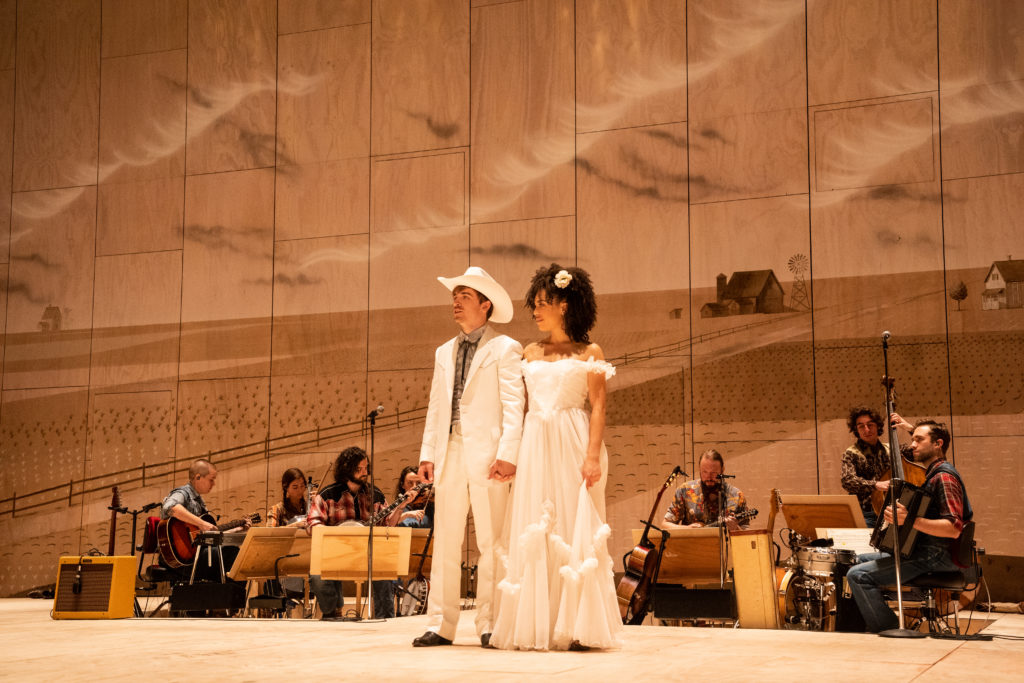
Rodgers and Hammerstein’s Oklahoma! continues in Nashville at TPAC’s Jackson Hall with performances thru Sunday, May 8. CLICK HERE for tickets.
Not in Nashville? Oklahoma! continues its North American Tour with dates across the US through the fall. CLICK HERE for show dates and locations or follow Oklahoma! on Facebook, Twitter and Instagram.
For more from Benj Mirman and Christopher Bannow check out their Instas.
As for TPAC, next up is the World Premiere presentation of May We All: A New Country Musical, June 7-July 17. Be sure to check out TPAC online and on socials by clicking any of the following: TPAC.org, TPAC on Instagram, TPAC on Facebook, TPAC on Twitter and TPAC on YouTube.
As always, if you wanna follow JHPEntertainment to find out who I’m chatting with for my next Rapid Fire Q&A, or for my take on the latest local and national theatre, music and movie offerings, find us at JHPEntertainment on Facebook, JHPEntertainment on Instagram and JHPEntertainment on Twitter.
Got an event or show we should know about, drop us a line at the Contact tab. Till then, #GoSeeTheShow!